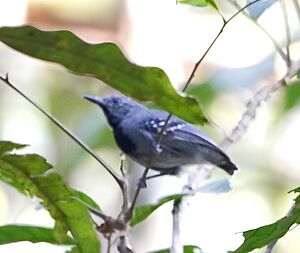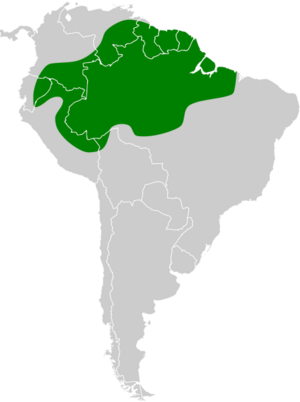Long-winged antwren facts for kids
Quick facts for kids Long-winged antwren |
|
|---|---|
 |
|
| Conservation status | |
| Scientific classification | |
| Genus: |
Myrmotherula
|
| Species: |
longipennis
|
 |
|
The long-winged antwren (Myrmotherula longipennis) is a small bird found in South America. It is part of the "typical antbirds" family, called Thamnophilidae. You can spot this bird in many countries. These include Bolivia, Brazil, Colombia, Ecuador, French Guiana, Guyana, Peru, Suriname, and Venezuela.
Contents
About the Long-winged Antwren
Naming and Types
The long-winged antwren was first described by an Austrian bird expert, August von Pelzeln, in 1868. He gave it its scientific name, Myrmotherula longipennis.
This bird has six different types, called subspecies. They are slightly different from each other:
- M. l. longipennis
- M. l. zimmeri
- M. l. garbei
- M. l. transitiva
- M. l. ochrogyna
- M. l. paraensis
Some experts have thought that a few of these subspecies might be different species entirely. The long-winged antwren and the band-tailed antwren are very closely related. They are part of a "superspecies" group.
What the Long-winged Antwren Looks Like
The long-winged antwren is a small bird, about 9 to 10.5 centimeters (3.5 to 4.1 inches) long. It weighs about 8 to 10 grams (0.28 to 0.35 ounces). It has a short tail.
Male and Female Birds
Adult male long-winged antwrens of the main subspecies (M. l. longipennis) have dark gray feathers on their backs. They have a hidden white patch between their shoulders. Their wings are dark gray with white tips on some feathers. Their tail is gray with white tips. Their throat and upper chest are black. The rest of their belly is a lighter gray.
Adult females look different. They have an orange-brown face and olive-brown feathers on their backs. Their tail and wings are dark grayish-brown. Their wing feathers have deep cinnamon-colored edges. Their throat and chest are light buff. The rest of their underside is mostly white with a gray tint.
Young males look similar to adult females. They have some light gray on their lower back.
Differences in Subspecies
Males of the other subspecies have white tips on their face feathers. They also have more black on their chest. Their underparts are usually paler.
Female subspecies also have unique looks:
- M. l. zimmeri: Has a pinkish-buff face and olive-gray upperparts. Its tail is dark gray. Its wing feathers have cinnamon-white edges. Its underside is deep cinnamon.
- M. l. garbei: Has more olive-colored upperparts than zimmeri. Its face is paler. Its wings have olive-buff tips. Its underside is a warm buff color.
- M. l. transitiva: Has a pale cinnamon-buff face. Its upperparts have a reddish tint. Its underside is light buff with a brownish shade on its sides.
- M. l. ochrogyna: Has a buff-brown face and reddish-brown upperparts. Its tail is brown. Its underside is orange-brown.
- M. l. paraensis: Has a cinnamon-buff face. Its upperparts and wing/tail feather edges are brownish-olive. Its underside is bright cinnamon-buff.
Where They Live and Their Home
Distribution of Subspecies
The different types of long-winged antwrens live in specific areas:
- M. l. longipennis: Found in southeastern Colombia, northeastern Ecuador, northern Peru, southern Venezuela, the Guianas, and northern Brazil.
- M. l. zimmeri: Lives in eastern Ecuador and northeastern Peru.
- M. l. garbei: Found in eastern Peru, northwestern Bolivia, and Brazil.
- M. l. transitiva: Lives in Brazil, between the upper Rio Madeira and upper Rio Tapajós rivers.
- M. l. ochrogyna: Found in Brazil, between the lower Rio Madeira and lower Rio Tapajós rivers.
- M. l. paraensis: Lives in Brazil, between the Rio Tapajós and western Maranhão, extending into northeastern Mato Grosso.
Habitat
The long-winged antwren lives in the lower and middle parts of evergreen forests. It also lives in older secondary forests. These birds prefer "terra firme" forests, which are on higher ground. They can also be found in "várzea" and "igapó" forests, which are often flooded.
They usually live below 500 meters (1,640 feet) in Colombia and Ecuador. In other lowlands, they can be found up to 700 meters (2,300 feet). In the Andean foothills, they go up to 900 meters (2,950 feet). On the Venezuelan "tepuis" (tabletop mountains), they can be found up to 1,100 meters (3,600 feet).
Behavior and Life
Movement
The long-winged antwren is thought to live in the same area all year round. It does not migrate.
Feeding Habits
This bird mainly eats insects and spiders. It searches for food alone, in pairs, or with its family. It often joins groups of different bird species that feed together.
It usually looks for food in thick plants, about 2 to 8 meters (7 to 26 feet) above the ground. Sometimes it goes as low as 1 meter (3 feet) or as high as 14 meters (46 feet). It mostly finds prey on thin branches of small trees, especially those with large leaves. It picks prey from leaves, dead leaf clusters, and tangled vines. It also catches prey by reaching, lunging, or making short flights from a perch.
Reproduction
We don't know much about the long-winged antwren's exact breeding season. However, it is known to breed from August to December in some areas. Their nests are deep cups made of plant fibers and covered with dead leaves. They hang their nests from branches up to about 12 meters (39 feet) above the ground. Both male and female birds feed the baby birds. We don't know how many eggs they lay or how long the eggs take to hatch.
Vocalization (Songs and Calls)
The songs of the different long-winged antwren subspecies are a bit different. The main subspecies (M. l. longipennis) sings a series of harsh, rising notes. It sounds like "high, nasal 'suee' notes."
The songs of M. l. zimmeri and M. l. garbei are a slow series of notes. Each note drops and then rises in pitch. The whole song gets higher in pitch. It sounds like "chuwey-chuwey-chuwey-chuwee-chuwee-chuwee."
The other three subspecies have slightly different songs. They are fast series of short, falling notes. They are mostly on the same pitch, but the last notes rise. The most common call is 2 to 6 whistles that drop in pitch. The number and length of these notes change between different birds.
Status and Protection
The IUCN (International Union for Conservation of Nature) says the long-winged antwren is a species of "Least Concern." This means it is not currently at risk of disappearing. It lives in a very large area. Even though we don't know its exact population size, it is believed to be stable.
There are no immediate threats to this bird. It is quite common throughout its range. It lives in many large protected areas. Also, there are huge areas of suitable forest that are not protected but seem safe from development for now.


